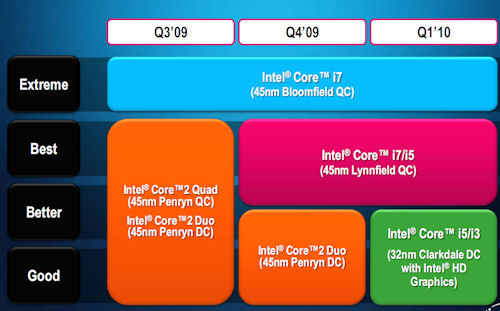32nm benefits: squeezing six cores in
Benefits of 32nm processIntel has already debuted the new 32nm CPU architecture on the desktop with the Clarkdale-based Core i5 6-series. The smaller process - 32nm vs. 45nm - has enabled the manufacturing giant to release a dual-core, four-threaded chip that includes the graphics component on the same package, linked via a high-speed interconnect called QPI. You can see where it fits into the product stack by looking at the picture, below.
A smaller manufacturing process gives rise to a number of enviable properties, as far as semiconductor companies are concerned. Simplifying it somewhat, a reduction in the size of transistors - the building blocks of CPUs - allows a) more transistors to be fitted into a same-sized area; good for economic reasons b) lower operating voltage to be used and c) more performance to be eked out of parts, due to a greater number of transistors.
Looking at the extreme segment that's currently dominated by the Core i7 900-series, a transition from 45nm to 32nm, ceteris paribus, would make the quad-core chips smaller, cheaper and more power-frugal. But Intel often sprinkles some architectural goodness when moving processes, and the change from Nehalem (45nm) to Westmere (32nm) is no exception.
Westmere as a high-end chip - using process qualities for six cores
The Westmere architecture is strictly speaking, a superset of Nehalem. The silicon contains seven new instructions incorporated to increase the speed of Advanced Encryption Standard (AES) encryption and decryption. Termed AES-NI and remembering that the new architecture is designed to cover server, desktop and client, Intel thinks that hardware-based encryption/decryption - security, in other words - is a worthwhile area in which to invest logic. The popular file-compression program WinZip 14 contains AES encryption, and our testing has shown Westmere to be 2.5x faster than Nehalem at the task.
That's all well and fine, you may say, but Intel is harnessing Westmere's smaller transistors and lower power-draw qualities by adding a couple of execution cores and more cache to the incumbent performance chip.
To be known as the Core i7 980X Extreme Edition, based on Westmere technology, the very newest chip in the high-end desktop space is imbued with six cores, 12 threads, and 12MB of L3 cache. That equates to a 50 per cent increase on a clock-for-clock basis when compared to Core i7 9xx.










